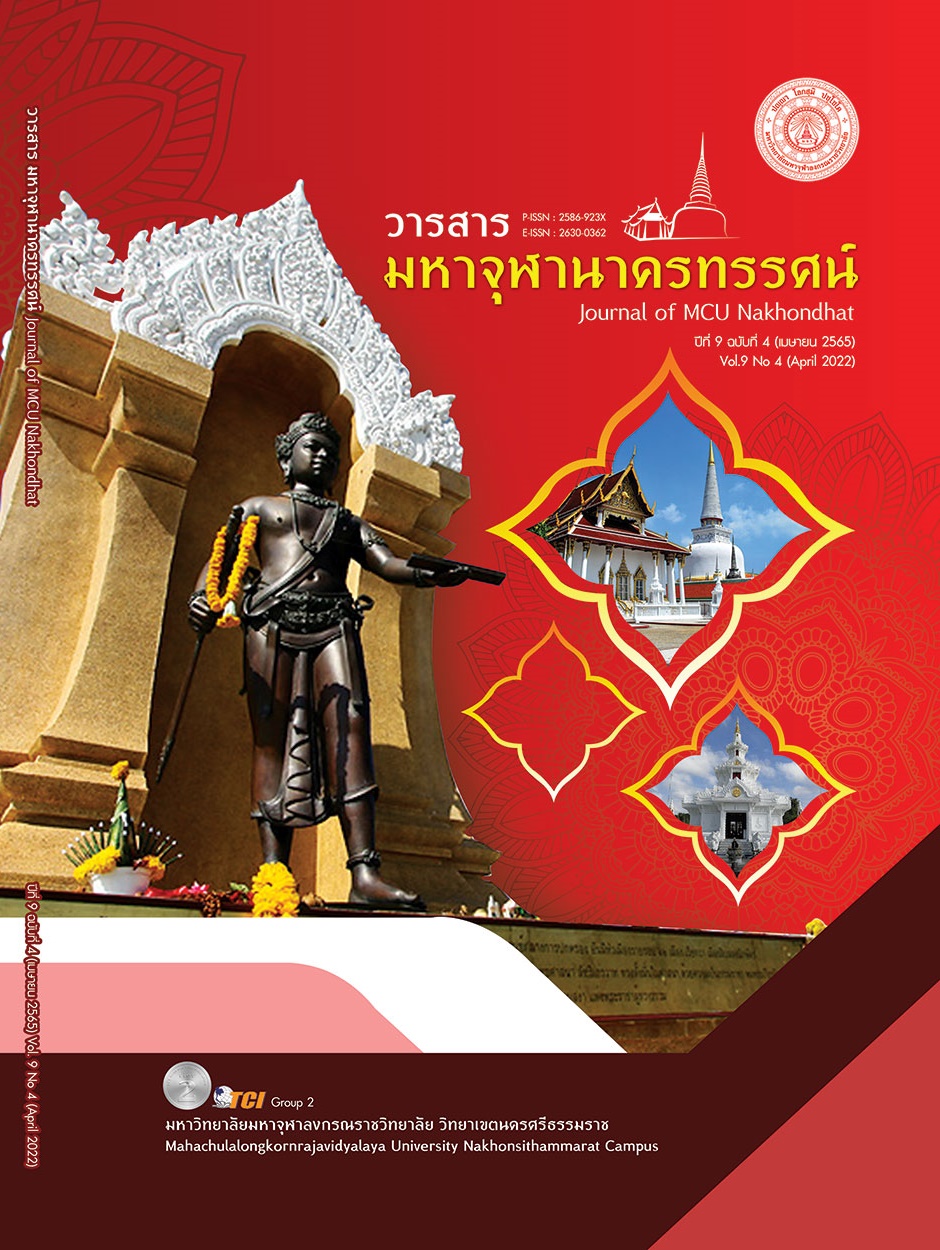FACTORS INFLUENCING THE ACCEPTANCE AND USAGE BEHAVIOR OF THE PAO TANG APPLICATION’S USERS
Main Article Content
Abstract
The objectives of this research were to study 1) the level of perceived usefulness, perceived ease of use, perceived compatibility, perceived risk and usage behavior of Pao Tang application’s users in Thailand; 2) the relationship among perceived usefulness, perceived ease of use, perceived compatibility, perceived risk and usage behavior of the users; and 3) the influence of perceived usefulness, perceived ease of use, perceived compatibility and perceived risk over the usage behavior of the users. A quantitative research, this study used a questionnaire to collect data from 400 users of Pao Tang application, aged 18 and over, selected via convenience sampling. The data were analyzed using Pearson's Product Moment Correlation Coefficient and Multiple Regression Analysis. The research found that 1) the level of perceived usefulness, perceived ease of use, perceived compatibility, perceived risk and usage behavior of the users were high; 2) perceived usefulness, perceived ease of use and perceived compatibility, except perceived risk, were positively correlated with the usage behavior of the users at the statistical significance level of 0.05; and 3) perceived usefulness, perceived ease of use and perceived compatibility, except perceived risk, had an influence over the usage behavior of the users at the statistical significance level of 0.05.
Article Details

This work is licensed under a Creative Commons Attribution-NonCommercial-NoDerivatives 4.0 International License.
References
กนกพร โชคจรัสกุล. (2564). คนคิดแอพฯ ‘เป๋าตัง เก่งแค่ไหน อาม่าอากงก็ใช้เป็น. เรียกใช้เมื่อ 19 กุมภาพันธ์ 2565 จาก https://www.bangkokbiznews.com/social/918597
กรุงเทพธุรกิจ. (2564). “ไทย” ยืนหนึ่งใช้ “Mobile Banking” 3 ปีซ้อน มูลค่ารวมปี 63 สูงกว่า 40 ล้านล้าน. เรียกใช้เมื่อ 19 กุมภาพันธ์ 2565 จาก https://www. bangkokbiznews.com/business/959448
ขวัญชนก กมลศุภจินดา. (2557). พฤติกรรมการใช้สื่อสังคมออนไลน์และการแสดงตัวตนของเจเนอ เรชั่น: กรณีศึกษาความแตกต่างระหว่างเจเนอเรชั่นเบบี้บูมเมอร์สและเจเนอเรชั่นวาย. ใน การค้นคว้าอิสระนิเทศศาสตรมหาบัณฑิต สาขาการสื่อสารเชิงกลยุทธ์. มหาวิทยาลัยกรุงเทพ.
ชูศรี วงศ์รัตนะ. (2544). เทคนิคการใช้สถิติเพื่อการวิจัย. (พิมพ์ครั้งที่ 8). กรุงเทพมหานคร: เทพเนรมิตการพิมพ์.
ทรูไอดี. (2563). รวม 5 ผลกระทบโควิด-19 ในปี 2020. เรียกใช้เมื่อ 24 สิงหาคม 2564 จาก https://news.trueid.net/detail/VGJ91QAkKvqN
ไทยโพสต์. (2564). แพลตฟอร์ม..เป๋าตัง ช่วย 'คนตัวเล็ก' สร้างธุรกิจ. เรียกใช้เมื่อ 5 สิงหาคม 2564 จาก https://www.thaipost.net/main/detail/106812
ไทยรัฐออนไลน์. (2564). ไทยใช้โมบายแบงกิ้งอันดับหนึ่งของโลก. เรียกใช้เมื่อ 10 สิงหาคม 2564 จาก https://www.thairath.co.th/business/finance/2031096
ธันยพร สุวัจนพรพงศ์. (2562). ปัจจัยที่มีผลต่อการยอมรับและพฤติกรรมการใช้แอพพลิเคชั่นหาคู่ออนไลน์ของกลุ่มผู้หญิงวัยทำงานในเขตกรุงเทพมหานคร. ใน วิทยานิพนธ์ศิลปศาสตรมหาบัณฑิต สาขานิเทศศาสตร์. มหาวิทยาลัยเกษตรศาสตร์.
ธีรวัตร อมรรัตนกิจ. (2560). ปัจจัยที่มีผลต่อความตั้งใจในการใช้บริการ QR Code Payment ผ่าน Mobile Banking ในเขตกรุงเทพมหานครและปริมณฑล. ใน การค้นคว้าอิสระบริหารธุรกิจมหาบัณฑิต สาขาบริหารธุรกิจ. มหาวิทยาลัยธรรมศาสตร์.
บุณยาพร จำนงค์ฤทธิ์. (2561). ศึกษาการยอมรับการใช้งานเทคโนโลยีกระเป๋าเงิน ออนไลน์ (e-Wallet). ใน การค้นคว้าอิสระบริหารธุรกิจมหาบัณฑิต สาขาบริหารธุรกิจ. มหาวิทยาลัยธรรมศาสตร์.
ประชาชาติธุรกิจ. (2563). เล็งคุ้มครอง e-Money สูงสุด 5 ล้านบาท/คน/แบงก์. เรียกใช้เมื่อ 10 สิงหาคม 2564 จาก https://www.prachachat.net/finance/news-532061
ประชาชาติธุรกิจ. (2564). เป๋าตัง แอปที่ทุกคนต้องมี มีดีมากกว่าแค่รับเงินเยียวยา. เรียกใช้เมื่อ 25 สิงหาคม 2564 จาก https://www.prachachat.net/finance/news-684466
วรัญธร พินิจจันทร์. (2563). การยอมรับการใช้งานแอพพลิเคชั่นไทยชนะ. ใน วิทยานิพนธ์ศิลปศาสตรมหาบัณฑิต สาขานิเทศศาสตร์. มหาวิทยาลัยเกษตรศาสตร์.
วลัญช์รัตน์ วงษ์ยะรา. (2563). ปัจจัยที่มีผลต่อการใช้กระเป๋าเงินอิเล็กทรอนิกส์ผ่านแอปพลิเคชันรูปแบบซูเปอร์แอป (SUPER APP): กรณีศึกษา แรบบิตไลน์เพย์และแกร็บเพย์. วารสารระบบสารสนเทศด้านธุรกิจ, 6(3), 11-28.
วิเชียร เกตุสิงห์. (2543). คู่มือการวิจัย : การวิจัยเชิงปฏิบัติ (พิมพ์ครั้งที่ 4). กรุงเทพมหานคร: เจริญผล.
ศรัณย์ธร ศศิธนากรแก้ว. (2561). ปัจจัยพยากรณ์ความตั้งใจในการใช้เครือข่ายสังคมออนไลน์ของพระสงฆ์ในเขตกรุงเทพมหานคร. วารสารวิจัยราชภัฏพระนคร สาขามนุษยศาสตร์และสังคมศาสตร์, 13(2), 177-190.
สภาดิจิทัลเพื่อเศรษฐกิจและสังคมแห่งประเทศไทย. (2563). ลดความเสี่ยง เลี่ยงสัมผัสเงินสด กับ 4 วิธีจ่ายเงินผ่านมือถือ เลี่ยงการติดเชื้อโควิด-19. เรียกใช้เมื่อ 8 กุมภาพันธ์ 2565 จาก https://www.dct.or.th/th/knowledge/detail/8
Cochran, W. G. (1977). Sampling Techniques. (3rd ed.). New York: John Wiley & Sons.
Davis, F. D. et al. (1989). User acceptance of computer technology: A comparison of two theoretical models. Management Science, 35(8), 982–1003.
Oliver, R. L. (1980). A cognitive model of the antecedents and consequences of satisfaction decisions. Journal of Marketing Research, 17(4), 460-469.
Rogers, E. M. (1995). Diffusion of Innovations. (4th ed.). New York: The Free Press.


